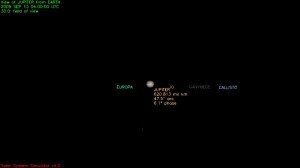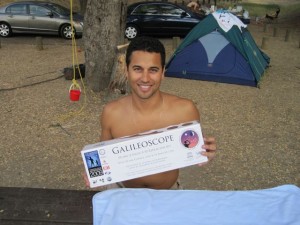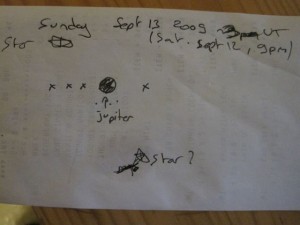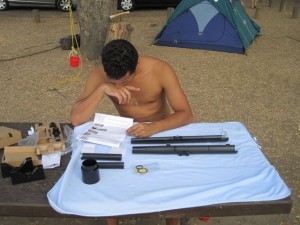I discovered the Galilean Satellites with my Galileoscope :-)
The Galileoscopes arrived – instructions and ideas for improvement
September 11, 2009The triple asteroid (93) Minerva – two additional observations!
September 15, 2009The end of the weekend… It was a very pleasant one since I went camping near Lake Camanche with my family and friends and we enjoyed a last glimpse of summer without Internet and G3. It gives me also the opportunity to test the Galileoscope. Guess what! I re-discovered the Galilean satellites 🙂
So I assembled and tested my Galileoscope successfully. It took me about 30 min to finalize it with its two eyepieces. The only tricky part was to make sure that the focuser tube is well set up to allow the sliding motion. The x18 eyepiece is not very useful, but I had fun using the x25 eyepiece. I used it on Saturday night and to my relief the Galileoscope revealed (despite some clouds, the fire camp of my neighbors and some pollution lights) the satellites of Jupiter.
Since I did not have a camera I drew on a piece of paper what I saw after focusing the telescope and fighting with my unreliable tripod.
So I may have discovered 400 years after Galileo Galilei, the Galilean satellites with the Galileoscope. The four of them were visible and perfectly aligned during my observation, none was in eclipse, in transit or in occultation. I noticed a bright star (V~5-6) located toward the south (don’t forget that the telescope provides images which are upside down, so it is on the top in my drawing).
Today, I used the JPL Solar System Simulator to check if I my observation was correct and to identify the Galilean satellites. Find below the parameters that I chose to display the appearance of the Jovian system at the time of my observation. The Universal Time (or UT) corresponds to the time on the Greenwich meridian (or GMT). The USNO Master Clock provides the Coordinated Universal Time (or UTC) on their web site: 9 pm (or 21:00) PDT (Pacific Daylight Time) corresponds to 4 am GMT, or ~04:00 UTC.

The Jovian system as generated using the JPL solar system simulator on the date and time of my observation (Sept 12 at 9 pm PDT)
The display that I obtained using the JPL solar system simulator confirms that the relative positions of the Galilean satellites that I reported in my drawing. The three Galilean satellites on the left of my drawing correspond to Io (closer), Ganymede and Callisto. The moon which was located on the other side is Europa. The veracity of the bright southern star is also confirmed.
I still remember how to find Jupiter in the sky with telescope… 🙂 It is always good to go back to the bases and enjoy watching the Heavens with friends.
My next step will be to try to x50 eyepieces and hopefully plug a camera to the Galileoscope. I will keep you posted.
Clear skies, F.






